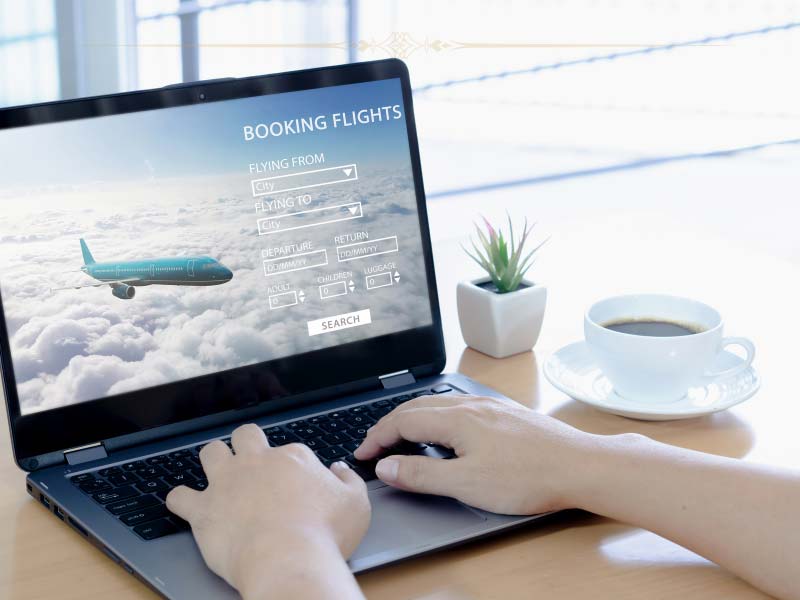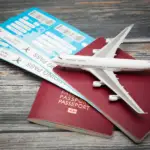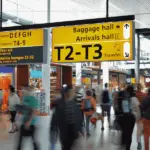The moment of realization hits like a bolt of lightning. You’ve just reviewed your airline ticket confirmation and noticed something alarming – your name isn’t spelled correctly. Perhaps it’s a simple typo, a nickname instead of your legal name, or maybe you forgot to update your married name on your booking. Whatever the case, this discovery often triggers immediate panic and questions about whether you’ll be allowed to board your flight.

Every year, thousands of travelers face this exact predicament. The good news is that most name discrepancies can be resolved, though the process varies by airline and the severity of the error. Understanding how to address the problem quickly and efficiently can mean the difference between a minor inconvenience and a major travel disruption.
This comprehensive guide explores the implications of misspelled names on airline tickets, the security concerns behind strict name-matching policies, and the steps you can take to correct errors before your departure date.
Why Names Matter in Air Travel
The aviation industry operates under strict security protocols, with passenger identification being a cornerstone of these measures. The Transportation Security Administration (TSA) and similar authorities worldwide require that the name on your boarding pass align with the name on your government-issued identification document. This requirement isn’t arbitrary – it serves several critical security functions.
First and foremost, accurate identification helps security personnel verify that the person boarding the aircraft is indeed the individual who purchased the ticket. This verification process is essential for preventing unauthorized access to aircraft and maintaining the integrity of passenger manifests. Additionally, security agencies use passenger names to cross-reference various watchlists and no-fly databases, further enhancing aviation security.
For international travel, the stakes are even higher. Immigration authorities rely on accurate passenger information to control border entries and exits. Discrepancies between travel documents and ticket information can trigger additional scrutiny, potentially leading to missed flights or even denied boarding in some cases.
The implementation of advanced passenger information systems (APIS) in recent years has further emphasized the importance of name accuracy. Many countries now require airlines to submit passenger data before departure, and this information must match passport details exactly. Even minor variations can flag a passenger for additional screening or create complications at immigration checkpoints.
Given these realities, airlines have developed specific policies for handling name errors on tickets, balancing security requirements with the understanding that honest mistakes do occur.
Types of Name Errors and Their Implications
Not all name errors are created equal in the eyes of airlines and security personnel. The severity of a mistake often determines both how easily it can be corrected and whether it might cause problems at the airport. Understanding these distinctions can help travelers assess their situation more accurately.
Minor typographical errors – such as transposed letters (Smith versus Smtih) or single-letter mistakes (Johnson versus Jonhson) – generally present the lowest level of concern. These obvious typos rarely trigger security flags provided the rest of the name is recognizable and the identification document clearly belongs to the passenger in question.
Abbreviated or nickname issues represent another common category of errors. Using “Mike” instead of “Michael” or “Beth” instead of “Elizabeth” on a ticket when your identification shows your legal name can create complications. While security agents are often familiar with common name variations, formal policy typically requires exact matches.
More significant discrepancies include completely different names (perhaps from accidentally entering another traveler’s information), substantially misspelled names that alter pronunciation or appearance, or last name changes due to marriage or divorce that haven’t been updated across all documents.
For international travelers, additional complexities arise with transliterated names from non-Latin alphabets. Even official documents might show different spellings of the same name, creating confusion about which version should appear on tickets.
The timing of discovery also significantly impacts the resolution process. Noticing a name error immediately after booking offers the most options for correction, while realizing the mistake at the check-in counter severely limits available remedies.
Airline Policies on Name Corrections
Airlines have developed varied approaches to handling name errors, reflecting differences in business models, technological capabilities, and customer service philosophies. Most carriers distinguish between minor corrections and complete name changes, with the latter being more strictly regulated to prevent ticket transfers.
Major legacy carriers typically maintain formal name correction policies. These airlines usually allow minor spelling corrections through their customer service channels but impose time limits – often requiring changes to be made at least 24-48 hours before departure. More significant name changes might incur substantial fees or require rebooking altogether, particularly for international flights where passenger information has already been submitted to authorities.
Budget airlines often implement more rigid policies, with some charging correction fees regardless of the error’s nature. These fees can sometimes approach or exceed the original ticket price, especially for last-minute corrections. The business model of these carriers, which relies on ancillary revenue streams, explains their less flexible approach to name changes.
Some airlines have modernized their correction processes by implementing self-service options through their websites or mobile applications. These tools typically allow passengers to make minor adjustments independently, though more substantial changes still require direct contact with customer service representatives.
The method of booking can also influence correction options. Tickets purchased directly from airlines usually offer more straightforward correction processes compared to those acquired through third-party booking sites or travel agencies, where coordination between multiple parties may be necessary.
Loyalty program status sometimes impacts the correction experience as well. Elite members often receive expedited service and may have change fees waived as a courtesy, highlighting the uneven application of official policies across different customer segments.
The 24-Hour Rule: A Valuable Safety Net
For travelers who discover name errors shortly after booking, the U.S. Department of Transportation’s 24-hour rule offers a valuable protection. This regulation requires airlines operating in the United States to allow passengers to cancel reservations within 24 hours of booking without penalty, provided the reservation was made at least seven days before the flight’s scheduled departure.
This rule effectively creates a window during which travelers can address name errors by simply canceling the incorrect booking and making a new reservation with the correct information. This approach circumvents the need to navigate complex name change policies and potentially avoids associated fees.
Several considerations make this option particularly attractive. First, the new booking typically preserves the original fare, eliminating concerns about price increases. Second, the process requires minimal interaction with customer service, allowing for quick resolution. Finally, the cancellation and rebooking process creates a clean slate, avoiding potential flags or complications that might arise from multiple corrections to a single reservation.
However, travelers should be aware of several limitations to this approach. The 24-hour window begins at the time of booking, not when the error is discovered, making prompt verification of booking details essential. Additionally, some budget carriers and international airlines may have exemptions or variations to this rule, particularly for special fares or promotional tickets.
For bookings made through third-party websites or travel agencies, the cancellation process might involve additional steps or restrictions. These intermediaries sometimes implement their own policies alongside the airline’s requirements, potentially complicating the correction process.
Despite these considerations, the 24-hour rule remains one of the most straightforward and cost-effective solutions for addressing name errors, provided they’re caught quickly enough.
Correcting Errors After the 24-Hour Window
When name errors are discovered beyond the 24-hour cancellation window, the correction process becomes more involved and potentially more expensive. Several approaches remain available, though each carries different implications for convenience and cost.
Contacting the airline’s customer service department represents the most direct approach. Representatives can assess the specific error and advise on available correction options based on the carrier’s policies. This contact should occur as soon as the error is identified, as many airlines impose deadlines for name corrections relative to the departure date.
When speaking with customer service, travelers should be prepared to provide several key pieces of information: the booking confirmation number, the incorrect name as it appears on the reservation, the correct name as it should appear, and the flight details. Having identification documents readily available during this conversation can facilitate verification and expedite the correction process.
For minor typographical errors, many airlines implement streamlined correction procedures with minimal or no fees. These corrections typically require supervisor approval but can often be processed during a single interaction. More substantial changes might necessitate formal documentation, such as marriage certificates for name changes due to marriage, or might trigger rebooking under the correct name.
The financial implications of corrections vary widely by airline and error type. Some carriers waive fees for obvious typographical mistakes while imposing substantial charges for more significant changes. These fees can range from nominal administrative charges to several hundred dollars for international flights or premium cabin bookings.
Timing significantly impacts both the availability and cost of corrections. Changes requested closer to the departure date generally face stricter scrutiny and higher fees, reflecting the administrative complexity of modifying passenger information in systems that have already processed the booking for operational purposes.
Special Circumstances: Legal Name Changes and Document Updates
Travelers who have legally changed their names face unique considerations when booking flights. Marriage, divorce, and court-ordered name changes create situations where identification documents might not align with each other, complicating the ticket booking process.
The Transportation Security Administration offers specific guidance for travelers in transition between names. According to official policy, passengers whose identification documents don’t match their current legal name can present supporting documentation, such as marriage certificates or court orders, alongside their primary identification. This accommodation allows travelers to fly even when their documents haven’t been fully updated to reflect recent name changes.
For international travel, the considerations become more complex. Immigration authorities typically require that passport information exactly match ticket information, making alignment between these documents particularly important. Travelers with recently changed names should prioritize updating their passports before booking international flights to avoid complications.
The recommended approach for travelers with recent name changes involves booking tickets under the name that appears on the identification document they plan to use at the airport. This strategy eliminates the need for corrections entirely and avoids potential complications at security checkpoints.
For those who cannot update all documents before travel, carrying supporting documentation becomes essential. Marriage certificates, divorce decrees, or court orders should be readily accessible throughout the journey, as they may be requested at multiple checkpoints from check-in through immigration.
What About Middle Names and Suffixes?
Middle names and name suffixes often create confusion for travelers, as policies regarding these elements vary between airlines and security agencies. Understanding these nuances can help avoid unnecessary corrections or airport complications.
For domestic travel within the United States, the TSA generally does not require that middle names appear on boarding passes exactly as they do on identification documents. A boarding pass showing only a middle initial when the ID shows the full middle name, or vice versa, typically causes no issues. Similarly, the absence of a middle name on either document when it appears on the other rarely triggers additional screening.
Name suffixes such as Jr., Sr., or III fall into a similar category for domestic travel. These designations are not considered critical identifying information by the TSA and discrepancies rarely cause problems.
However, international travel introduces stricter requirements. Many countries and their immigration authorities expect exact matches between passport information and flight manifests, including middle names and suffixes. This expectation stems from the use of this information in security databases and watchlist screening.
The safest approach for international travelers involves including all name elements exactly as they appear on the passport when booking tickets. This practice ensures alignment with APIS requirements and minimizes the potential for questions or delays at various checkpoints.
For travelers who discover discrepancies related to middle names or suffixes, the urgency of correction depends on the travel context. For domestic flights, minor variations rarely warrant the time and potential expense of formal corrections. For international journeys, however, addressing these differences becomes more important, particularly for travel to countries known for strict documentation requirements.
Airport Solutions for Unresolved Name Issues
Despite best efforts to correct name errors in advance, some travelers inevitably reach the airport with unresolved discrepancies. While this situation is far from ideal, several options remain available for addressing the issue at the eleventh hour.
The airport customer service counter represents the first line of assistance. Airline representatives can access reservation systems and make certain last-minute adjustments that might not be available through other channels. These personnel have experience with common documentation issues and can often implement solutions that balance security requirements with customer needs.
For minor typographical errors identified at check-in, many airlines empower their agents to make corrections on the spot. This authority typically extends to obvious misspellings or transposed letters that don’t substantially alter the name. More significant discrepancies might require supervisor intervention or additional documentation.
Arriving early becomes particularly important when name issues remain unresolved. The standard recommendation of arriving two hours before domestic flights and three hours before international departures should be extended further when documentation complications are anticipated. This buffer allows time for resolution without creating additional stress from approaching departure times.
Politeness and patience significantly impact the airport resolution process. Customer service representatives have discretion in many cases, and constructive engagement increases the likelihood of favorable outcomes. Explaining the situation clearly and providing all relevant documentation helps agents understand the nature of the discrepancy and identify appropriate solutions.
For truly intractable situations where corrections cannot be made and the discrepancy prevents boarding, most airlines will offer to rebook the passenger on a later flight with the correct information. While this outcome is disruptive and potentially costly, it represents a last-resort option for continuing the journey when other approaches have failed.
Preventive Measures for Future Bookings
Having experienced the stress and potential complications of name errors, travelers can implement several preventive strategies to avoid similar issues on future journeys.
Creating a standardized booking profile represents one of the most effective approaches. This profile should include the traveler’s name exactly as it appears on their primary identification document, typically a passport for international travelers or a driver’s license for domestic journeys. Using this consistent information for all bookings eliminates variations that might creep in through repeated manual entry.
Many airlines and online travel agencies offer stored profile options that automatically populate booking forms with verified information. Utilizing these features reduces the risk of typing errors while saving time during the reservation process. Similarly, loyalty program profiles typically store verified name information that aligns with identification documents.
For families or groups traveling together, special attention should be paid to individual name entry. The reservation process often involves entering multiple names sequentially, creating opportunities for mix-ups or automated population of fields with previously entered information. Reviewing each traveler’s details independently helps catch these potential errors.
Confirmation emails deserve more than a cursory glance. These communications typically arrive immediately after booking and provide the first opportunity to identify and address name discrepancies. Developing a habit of carefully reviewing all passenger information in these emails can catch errors within the critical 24-hour window when corrections are simplest.
For travelers with complex naming situations – those with hyphenated surnames, multiple middle names, or names that contain special characters – additional vigilance is warranted. These less common name structures are more prone to system limitations or interpretation errors during the booking process.
Final Considerations
The issue of misspelled names on airline tickets illustrates the intersection of customer service flexibility and security requirements in modern air travel. While airlines recognize that honest mistakes occur, they must balance correction accommodations with legitimate security concerns and business considerations.
As identification verification technology continues to advance, including biometric systems that rely less on exact name matching, some of these challenges may eventually diminish. However, for the foreseeable future, accurate name information remains a critical element of the air travel experience.
The key takeaway for travelers is that prevention remains far simpler than correction. Taking the time to enter and verify name information correctly during initial booking saves considerable stress, potential expense, and administrative hassle later in the journey. When errors do occur, prompt action, clear communication, and appropriate documentation significantly improve the likelihood of straightforward resolution.
By understanding airline policies, security requirements, and available correction options, travelers can approach name discrepancies with confidence rather than panic. While misspelled names can certainly create complications, they rarely result in insurmountable barriers to completing planned travel when addressed properly and proactively.





This is great, I always say it’s good to know these things so that if a situation arises you can stay calm and know what to do. Do you have any info on first and middle names becoming one name? This often happens with international flights, you put the names in correctly and then the system squishes the two together. It seems it shouldn’t be a problem but many travelers panic because it isn’t an exact match to their passport. Example; John Paul Smith becomes Johnpaul Smith.
There is no problem if the system squishes your two names together. 🙂